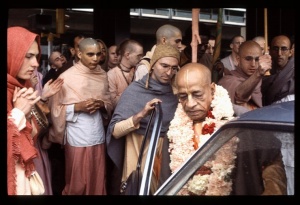SB 10.2.8

A.C. Bhaktivedanta Swami Prabhupada
TEXT 8
- devakyā jaṭhare garbhaṁ
- śeṣākhyaṁ dhāma māmakam
- tat sannikṛṣya rohiṇyā
- udare sanniveśaya
SYNONYMS
devakyāḥ — of Devakī; jaṭhare — within the womb; garbham — the embryo; śeṣa-ākhyam — known as Śeṣa, the plenary expansion of Kṛṣṇa; dhāma — the plenary expansion; māmakam — of Me; tat — Him; sannikṛṣya — attracting; rohiṇyāḥ — of Rohiṇī; udare — within the womb; sanniveśaya — transfer without difficulty.
TRANSLATION
Within the womb of Devakī is My partial plenary expansion known as Saṅkarṣaṇa or Śeṣa. Without difficulty, transfer Him into the womb of Rohiṇī.
PURPORT
The first plenary expansion of Kṛṣṇa is Baladeva, also known as Śeṣa. The Śeṣa incarnation of the Supreme Personality of Godhead supports the entire universe, and the eternal mother of this incarnation is mother Rohiṇī. "Because I am going into the womb of Devakī," the Lord told Yogamāyā, "the Śeṣa incarnation has already gone there and made suitable arrangements so that I may live there. Now He should enter the womb of Rohiṇī, His eternal mother."
In this connection, one may ask how the Supreme Personality of Godhead, who is always situated transcendentally, could enter the womb of Devakī, which had previously been entered by the six asuras, the ṣaḍ-garbhas. Does this mean that the Ṣaḍ-garbhāsuras were equal to the transcendental body of the Supreme Personality of Godhead? The following answer is given by Śrīla Viśvanātha Cakravartī Ṭhākura.
The entire creation, as well as its individual parts, is an expansion of the energy of the Supreme Personality of Godhead. Therefore, even though the Lord enters the material world, He does not do so. This is explained by the Lord Himself in Bhagavad-gītā (BG 9.4-5):
- mayā tatam idaṁ sarvaṁ
- jagad avyakta-mūrtinā
- mat-sthāni sarva-bhūtāni
- na cāhaṁ teṣv avasthitaḥ
- na ca mat-sthāni bhūtāni
- paśya me yogam aiśvaram
- bhūta-bhṛn na ca bhūta-stho
- mamātmā bhūta-bhāvanaḥ
"By Me, in My unmanifested form, this entire universe is pervaded. All beings are in Me, but I am not in them. And yet everything that is created does not rest in Me. Behold My mystic opulence! Although I am the maintainer of all living entities, and although I am everywhere, My Self is the very source of creation." Sarvaṁ khalv idaṁ brahma. Everything is an expansion of Brahman, the Supreme Personality of Godhead, yet everything is not the Supreme Godhead, and He is not everywhere. Everything rests upon Him and yet does not rest upon Him. This can be explained only through the acintya-bhedābheda philosophy. Such truths cannot be understood, however, unless one is a pure devotee, for the Lord says in Bhagavad-gītā (BG 18.55), bhaktyā mām abhijānāti yāvān yaś cāsmi tattvataḥ: "One can understand the Supreme Personality as He is only by devotional service." Even though the Lord cannot be understood by ordinary persons, this principle should be understood from the statement of the śāstras.
A pure devotee is always transcendentally situated because of executing nine different processes of bhakti-yoga (śravaṇaṁ kīrtanaṁ viṣṇoḥ smaranaṁ pāda-sevanam/ arcanaṁ vandanaṁ dāsyaṁ sakhyam ātma-nivedanam (SB 7.5.23)). Thus situated in devotional service, a devotee, although in the material world, is not in the material world. Yet a devotee always fears, "Because I am associated with the material world, so many contaminations affect me." Therefore he is always alert in fear, which gradually diminishes his material association.
Symbolically, mother Devakī's constant fear of Kaṁsa was purifying her. A pure devotee should always fear material association, and in this way all the asuras of material association will be killed, as the ṣaḍ-garbhāsuras were killed by Kaṁsa. It is said that from the mind, Marīci appears. In other words, Marīci is an incarnation of the mind. Marīci has six sons: Kāma, Krodha, Lobha, Moha, Mada and Mātsarya (lust, anger, greed, illusion, madness and envy). The Supreme Personality of Godhead appears in pure devotional service. This is confirmed in the Vedas: bhaktir evainaṁ darśayati. Only bhakti can bring one in contact with the Supreme Personality of Godhead. The Supreme Personality of Godhead appeared from the womb of Devakī, and therefore Devakī symbolically represents bhakti, and Kaṁsa symbolically represents material fear. When a pure devotee always fears material association, his real position of bhakti is manifested, and he naturally becomes uninterested in material enjoyment. When the six sons of Marīci are killed by such fear and one is freed from material contamination, within the womb of bhakti the Supreme Personality of Godhead appears. Thus the seventh pregnancy of Devakī signifies the appearance of the Supreme Personality of Godhead. After the six sons Kāma, Krodha, Lobha, Moha, Mada and Mātsarya are killed, the Śeṣa incarnation creates a suitable situation for the appearance of the Supreme Personality of Godhead. In other words, when one awakens his natural Kṛṣṇa consciousness, Lord Kṛṣṇa appears. This is the explanation given by Śrīla Viśvanātha Cakravartī Ṭhākura.